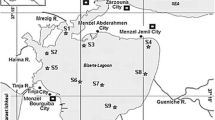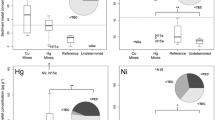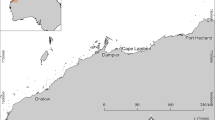Abstract
Analytical measurements are commonly used to screen for toxicity or lack of toxicity from sediment-associated copper. Comparisons of analytical measurements with toxicological responses can be useful for determining the practicality of analytical measurements for assessing the toxicity of copper in sediments. The purpose of this research was to determine the utility of method detection limits (MDLs; i.e., minimum concentration of an analyte such as copper that can be measured with 99 % confidence with a specific analytical method and matrix) to predict the bioavailability of copper in five different sediments. The specific objectives of this research were to (1) select and characterize five sediments with different characteristics, (2) amend and measure a range of copper concentrations in the five sediments to determine MDLs and bioavailability of copper amendments in those sediments, (3) discern relationships with sediment characteristics to MDLs and bioavailability of copper in the five sediments, and (4) compare MDLs and observed toxicity to Hyalella azteca Saussure as an indicator of copper bioavailability in the five sediments. The lowest copper concentrations that elicited an observable adverse effect ranged from 15 to 550 mg Cu/kg, and the MDLs ranged from 1.5 to 6 mg Cu/kg. The MDLs and measured copper concentrations were not adequately predictive of the bioavailability and toxicity of copper in the five sediments. No adverse effects were observed for H. azteca exposed for 10 days to the sediment from California with simultaneously extractable metals > acid-volatile sulfides. Since the lowest observed effects concentrations of copper in the five sediments ranged two orders of magnitude, the National Oceanic and Atmospheric Administration screening values (threshold and probable effect levels) were not predictive of H. azteca responses to the copper-amended sediments.





Similar content being viewed by others
References
Acar, O. (2006). Determination of cadmium, chromium, copper, and lead in sediments and soil samples by electrothermal atomic absorption spectrometry using zirconium containing chemical modifiers. The Japan Society for Analytical Chemistry, 22, 731–735.
Allen, H. E., Gomgmin, F., & Deng, B. (1993). Analysis of acid-volatile sulfide (AVS) and simultaneously extracted metals (SEM) for the estimation of potential toxicity in aquatic sediments. Environmental Toxicology and Chemistry, 12, 1441–1453.
Ankley, G. T., Mattson, V. R., Leonard, E. N., West, C. W., & Bennett, J. L. (1993). Predicting the acute toxicity of copper in freshwater sediments: evaluation of the role of acid-volatile sulfide. Environmental Toxicology and Chemistry, 12, 315–320.
Ankley, G. T., Thomas, N. A., Di Toro, D. M., Hansen, D. J., Hanony, J. D., Berry, W. J., Swartz, R. C., Hoke, R. A., Garrison, W. A., Allen, H. E., & Zabra, C. S. (1994). Assessing potential bioavailability of metals in sediments: a proposed approach. Environmental Management, 13, 331–337.
American Public Health Association (APHA). (2005). Standard methods for the examination of water and wastewater (21st ed.). Washington, DC: American Public Health Association.
Bailey, G. W., & White, J. L. (1964). Review of adsorption of organic pesticides by soil colloids, with implications concerning pesticide bioactivity. Journal of Agricultural and Food Chemistry, 12, 324–332.
Besser, J. M., Brumbaugh, W. G., May, T. W., & Ingersoll, C. G. (2003). Effects of organic amendments on the toxicity and bioavailability of cadium and copper in spiked formulated sediments. Environmental Toxicology and Chemistry, 22(3), 805–815.
Blake, G. R. (1965). Bulk density. In C. A. Black (Ed.), Methods of soil analysis: part 1 (2nd ed., pp. 107–123). Madison, WI: American Society of Agronomy.
Buchman, M. F. (2008). NOAA screening quick reference tables, NOAA OR&R report 08–1. Seattle WA, Office of Response and Restoration Division, National Oceanic and Atmospheric Administration
Burton, G. A. (1991). Assessing the toxicity of freshwater sediments. Environmental Toxicology and Chemistry, 10, 1585–1627.
Cairns, M. A., Nebeker, A. V., Gakstatter, J. N., & Griffis, W. L. (1984). Toxicity of copper-spiked sediments to freshwater invertebrates. Environmental Toxicology and Chemistry, 3, 435–445.
Chapman, P. M., William, A. J., & Green, A. (1998). Appropriate applications of sediment quality values for metals and metalloids. Journal of Environmental Science and Technology, 33(22), 3937–3941.
Creed, J., Martin, T., & O’Dell, J. (1994). Method 200.9 determination of trace elements by stabilized temperature graphite furnace atomic absorption, revision 2.2. Environmental Monitoring Systems Laboratory Office of Research and Development U.S. Environmental Protection Agency Cincinnati, OH, 45268
Di Toro, D. M., Mahony, J. J., Hansen, D. J., Scott, K. J., Hicks, M. B., Mayr, S. M., & Redmend, M. S. (1990). Toxicity of cadmium in sediments: the role of acid volatile sulfide. Environmental Toxicology and Chemistry, 9, 1487–1502.
Deaver, E., & Rodgers, J. H., Jr. (1996). Measuring bioavailable copper using anodic stripping voltammetry. Environmental Toxicology and Chemistry, 15(11), 1925–1930.
de March, B. G. E. (1981). Hyalella azteca (Saussure). In S. G. Lawrence (Ed.), Manual for the culture of selected freshwater invertebrates (pp. 61–77). Ottawa: Department of Fisheries and Oceans.
Enzweiler, J., & Vendemiatto, M. (2004). Analysis of sediments and soils by x-ray fluorescence spectrometry using matrix corrections based on fundamental parameters. Geostandards Geoanalytical Resources., 28, 103–112.
Flemming, C. A., & Trevors, J. T. (1989). Copper toxicity and chemistry in the environment: a review. Water, Air, and Soil Pollution, 44, 143–158.
Gallagher, J., Duke, B., & Rodgers, J. H., Jr. (2005). Responses of Hyalella azteca and Ceriodaphnia to reservoir sediments following chelated copper herbicide applications. Journal of Aquatic Plant Management, 43, 95–99.
Gee, G. W., & Bauder, J. W. (1986). Particle-size analysis. In C. A. Black (Ed.), Methods of soil analysis: part 1 (2nd ed., pp. 383–410). Madison: American Society of Agronomy.
Gillis, A. C., & Birch, G. F. (2006). Investigation of anthropogenic trace metals in sediments of Lake Illawarra, New South Wales. Australian Journal of Earth Sciences, 53, 523–539.
Hoss, H., Haitzer, M., Traunspurger, W., Gratzer, H., Ahlf, W., & Steinberg, C. (1997). Influence of particle size distribution and content of organic matter on the toxicity of copper in sediment bioassays using Caenorhabditis elegans (Nematoda). Water, Air, and Soil Pollution, 99, 689–695.
Huggett, D. B., Gillespie, W. B., & Rodgers, J. H., Jr. (1999). Copper bioavailability in Steilacoom Lake sediments. Archives of Environmental Contamination and Toxicology, 36, 120–123.
Johnson, B. M., Chao, M. M., Tedrow, O. R., McQueen, A. D., & Rodgers, J. H., Jr. (2008). Responses of Lepomis macrochirus, Pimephales promelas, Hyalella azteca, Ceriodaphnia dubia, and Daphnia magna to exposures of Algimycin® PWF and copper sulfate pentahydrate. Journal of Aquatic Plant Management, 46, 176–183.
Jones, R. P., Hassan, S. M., & Rodgers, J. H., Jr. (2008). Influence of contact duration on sediment-associated copper fractionation and bioavailability. Ecotoxicology and Environmental Safety, 71, 104–116.
Kimbrough, D., & Wakakuwa, J. (1993). Method detection limits in solid waste analysis. Environmental Science & Technology, 27, 2692–2699.
Kubitz, J. A., Lewek, E. C., Besser, J. M., Drake, J. B., III, & Giesy, J. P. (1995). Effects of copper-contaminated sediments on Hyalella azteca, Daphnia magna, and Ceriodaphnia dubia: survival, growth, and enzyme inhibition. Archives of Environmental Contamination and Toxicology, 29, 97–103.
Laing, G. D., Rinklebe, J., Vandecasteele, B., Meers, E., & Tack, F. M. G. (2009). Trace metal behavior in estuarine and riverine floodplain soils and sediments: a review. Science of the Total Environment, 407, 3972–3985.
Leonard, E. N., Cotter, A. M., & Ankley, G. T. (1996). Modified diffusion method for analysis of acid volatile sulfides and simultaneously extracted metals in freshwater sediments. Environmental Toxicology and Chemistry, 15(9), 1479–1481.
MacDonald, D. D., Ingersoll, C. G., & Berger, T. A. (2000). Development and evaluation of consensus-based sediment quality guidelines for freshwater ecosystems. Archives of Environmental Contamination and Toxicology, 39, 20–31.
Milani, D., Reynoldson, T. B., Borgmann, U., & Kolasa, J. K. (2003). The relative sensitivity of four benthic invertebrates to metal spiked-sediment exposures and application to contaminated field sediment. Environmental Toxicology and Chemistry, 22(4), 845–854.
Murray-Gulde, C. L., Heatley, J. E., Schwartzman, A. L., & Rodgers, J. H., Jr. (2002). Algicidal effectiveness of Clearigate, Curtrine-Plus, and copper sulfate and margins of safety associated with their use. Archives of Environmental Contamination and Toxicology, 43, 19–27.
Nelson, D. W., & Sommers, L. E. (1986). Total carbon, organic carbon, and organic matter. In W. C. Black (Ed.), Methods of soil analysis, part 1 (pp. 539–568). Wisconsin: American Society of Agronomy.
Plumb, R. H. Jr. (1981) Procedures for handling and chemical analysis of sediment and water samples. Technical Report EPA/CE-18-1. Vicksburg, MS: U.S. Army Engineer Waterways Experiment Station
SAS Institute Inc. (2010). SAS/STAT user’s guide, SAS 9.2. North Carolina: SAS Institute Inc.
Suedel, B. C., & Rodgers, J. H., Jr. (1991). Variability of bottom sediment characteristics of the continental United States. Water Resources Bulletin, 27, 101–109.
Suedel, B. C., Deaver, E., & Rodgers, J. H., Jr. (1996). Experimental factors that may affect toxicity of aqueous and sediment-bound copper to freshwater organisms. Archives of Environmental Contamination and Toxicology, 30, 40–46.
Teasdale, P. R., Apte, S. C., Ford, P. W., Batley, G. E., & Koehnken, L. (2003). Geochemical cycling and speciation of copper in waters and sediments of Macquarie Harbour, Western Tasmania. Estuarine, Coastal and Shelf Science, 57, 475–487.
US EPA. (1996). Method 3050b: acid digestion of sediments, sludges, and soil, revision 2. United States Environmental Protection Agency. http://www.epa.gov/wastes/hazard/testmethods/sw846/pdfs/3050b.pdf. Accessed 23 May 2011.
US EPA. (2000). Methods for measuring the toxicity and bioaccumulation of sediment-associated contaminants with freshwater invertebrates. EPA 600/R-99/064 Duluth, MN: United States Environmental Protection Agency.
Acknowledgments
The authors would like to thank Burton Suedel, James Castle, and the anonymous reviewers for their helpful comments. The authors are grateful for the financial support provided by the Lonza Group Ltd., and aid from Brian Lind, Burton Suedel, Curt Cress, and Harry Knight with sediment sample collection.
Author information
Authors and Affiliations
Corresponding author
Rights and permissions
About this article
Cite this article
Willis, B.E., Alley, B.L. & Rodgers, J.H. Bioavailability and Analytical Measurement of Copper Residuals in Sediments. Water Air Soil Pollut 224, 1423 (2013). https://doi.org/10.1007/s11270-012-1423-y
Received:
Accepted:
Published:
DOI: https://doi.org/10.1007/s11270-012-1423-y




